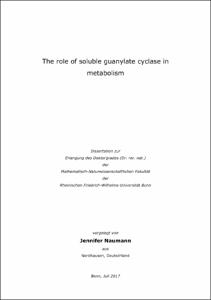The role of soluble guanylate cyclase in metabolism

The role of soluble guanylate cyclase in metabolism

| dc.contributor.advisor | Pfeifer, Alexander | |
| dc.contributor.author | Naumann, Jennifer | |
| dc.date.accessioned | 2020-04-25T12:47:59Z | |
| dc.date.available | 2020-04-25T12:47:59Z | |
| dc.date.issued | 31.10.2018 | |
| dc.identifier.uri | https://hdl.handle.net/20.500.11811/7659 | |
| dc.description.abstract | Obesity is a worldwide health problem characterized by a chronic positive energy balance. The excess energy is stored primarily as lipids (TGs) in white adipose tissue (WAT). In contrast, brown adipose tissue (BAT) utilizes energy to produce heat in response to cold exposure. BAT is a promising target for developing anti-obesity therapies. This thesis focusses on the role of soluble guanylate cyclase (sGC) in metabolism and identifies BATcentered therapies. Analysis of sGCβ1 knockout mice revealed reduced BAT mass and less UCP1 expression in comparison to WT mice. Furthermore, differentiation and function of brown adipocytes was impaired in mice lacking the β1 subunit of sGC. Congruently, chronic stimulation of sGC with 3 μM BAY 41-8543 during differentiation of brown adipocytes (BAs) resulted in improved adipogenic (PPARg and aP2) and thermogenic marker (PGC-1a and UCP1) expression. Functionally, lipolysis, was also enhanced in BAs treated with BAY 41-8543. Pharmacological stimulation of sGC during a high fat diet regime protects against weight gain. Stimulation of sGC increases function of BAs and energy consumption by UCP1 mediated thermogenesis. Importantly, BAY 41-8543 counteracts comorbidities of obesity, such as fatty liver and diabetes, even in already established obesity via increased energy expenditure. Notably, mice treated with the sGC stimulator exhibited reduced "whitening" of BAT and enhanced "browning" of WAT. In addition, sGC stimulation leads to increased expression of mitochondrial markers in muscle, which shows the overall effect of sGC stimulation. Stimulation of sGC results in increased lipid uptake and utilization by BAT, WATi, liver and muscle. Overall, sGC stimulation leads to reduced body weight gain, even in obese mice. Moreover, sGC stimulation improves metabolic phenotype in mice with diet-induced obesity (DIO), as well as on control diet (CD). Therefore, sGC stimulators represent a novel pharmacological approach for the treatment of obesity and its comorbidities. | en |
| dc.language.iso | eng | |
| dc.rights | In Copyright | |
| dc.rights.uri | http://rightsstatements.org/vocab/InC/1.0/ | |
| dc.subject | Metabolismus | |
| dc.subject | lösliche Guanylatzyklase | |
| dc.subject | Fettgewebe | |
| dc.subject | Übergewicht | |
| dc.subject | Diabetes mellitus | |
| dc.subject | metabolism | |
| dc.subject | soluble guanylate cyclase | |
| dc.subject | adipose | |
| dc.subject | tissue | |
| dc.subject | obesity | |
| dc.subject.ddc | 500 Naturwissenschaften | |
| dc.title | The role of soluble guanylate cyclase in metabolism | |
| dc.type | Dissertation oder Habilitation | |
| dc.publisher.name | Universitäts- und Landesbibliothek Bonn | |
| dc.publisher.location | Bonn | |
| dc.rights.accessRights | openAccess | |
| dc.identifier.urn | https://nbn-resolving.org/urn:nbn:de:hbz:5n-52380 | |
| ulbbn.pubtype | Erstveröffentlichung | |
| ulbbn.birthname | Etzrodt | |
| ulbbnediss.affiliation.name | Rheinische Friedrich-Wilhelms-Universität Bonn | |
| ulbbnediss.affiliation.location | Bonn | |
| ulbbnediss.thesis.level | Dissertation | |
| ulbbnediss.dissID | 5238 | |
| ulbbnediss.date.accepted | 26.01.2018 | |
| ulbbnediss.institute | Medizinische Fakultät / Institute : Institut für Pharmakologie und Toxikologie | |
| ulbbnediss.fakultaet | Mathematisch-Naturwissenschaftliche Fakultät | |
| dc.contributor.coReferee | Mohr, Klaus |
Files in this item
This item appears in the following Collection(s)
-
E-Dissertationen (4169)




